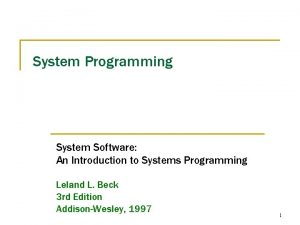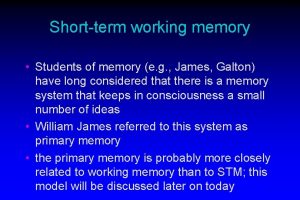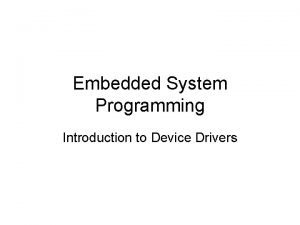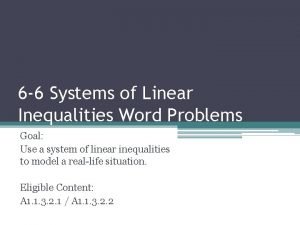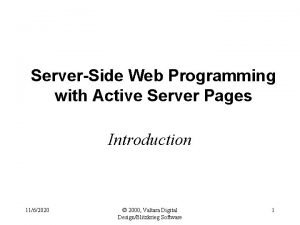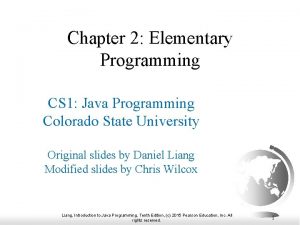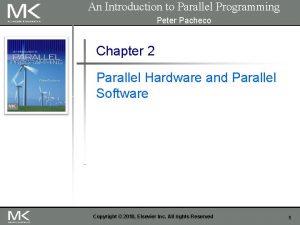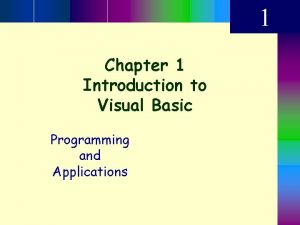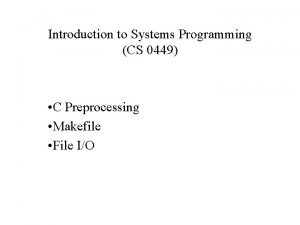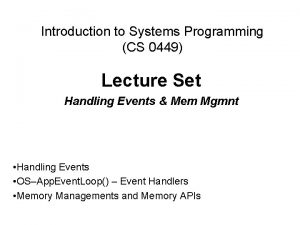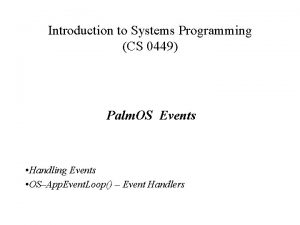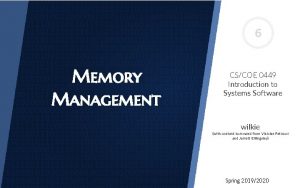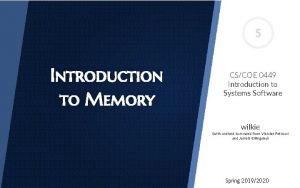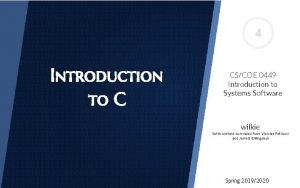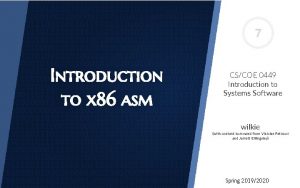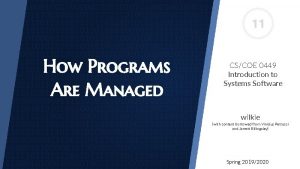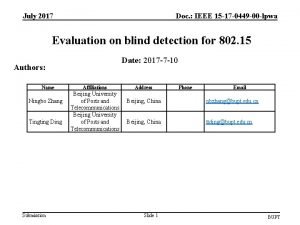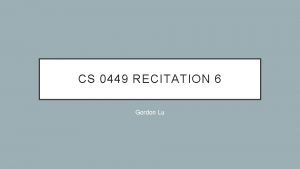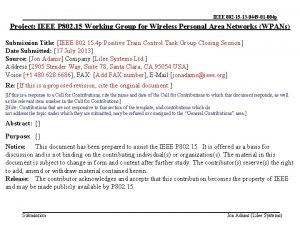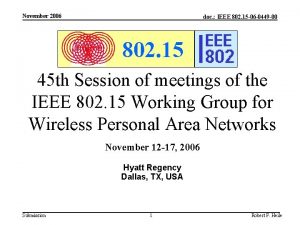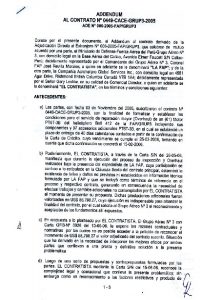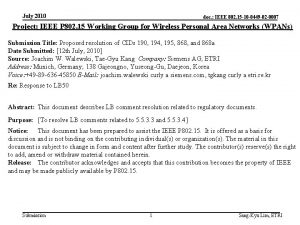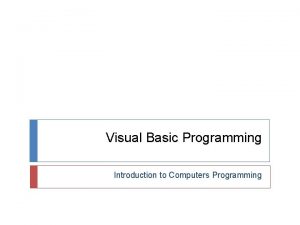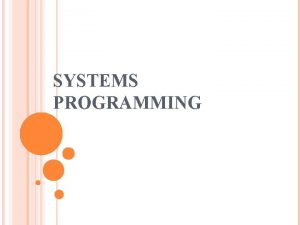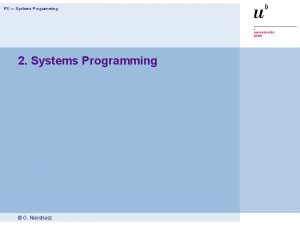Introduction to Systems Programming CS 0449 Working with


























- Slides: 26

Introduction to Systems Programming (CS 0449) • Working with clipboard –(pg 333, Palm. OS Bible) – Chapter 9. –Palm. OS SDK Reference ->User Interface -> Clipboard

Popular Linking Error • Some have received strange error message: My. Palm. Main. o(. text+0 x 1 ac): My. Palm. Main. c: 111: undefined reference to `Fld. Set. New. Text' • The cause: Linker could not find Fld. Set. New. Text() definition in the object files. • Possible cause: Fld. Set. New. Text() was declared as static • "static" for functions means "do not use outside the module" • Remove "static" if you want to make the function public.

Checking Supported Features • Features are – Hardware (Processor ID, graphics features, serial ports. . . ) – OS features (version number. . . ) • Before using a feature check if it is present

Supported Features (1) • Determining Palm OS version (pg 306, Palm. OS Bible Ch. 9) UInt 32 version; Ftr. Get ( sys. Ftr. Creator, sys. Ftr. Num. ROMVersion, & version ); if ( sys. Get. ROMVer. Major ( version ) = = 5) { // version 5. xx. . . } else { // version 4. xx or lower. . . } Example: Format= 0 x. MMmfsbbb MM: Major version m: Minor version f: Bug fix version number s: Release stage 0: development 1: alpha 2: beta 3: release bbb: build number for nonreleases sys. Get. ROMVer. Major sys. Get. ROMVer. Minor sys. Get. ROMver. Fix sys. Get. ROMVer. Stage sys. Get. ROMVer. Build

Supported Features (2) • Checking CPU (pg 308, Palm. OS Bible – Ch. 9) UInt 32 cpu. ID; Ftr. Get ( sys. Ftr. Creator, sys. Ftr. Num. Processor. ID, & cpu. ID ); if (cpu. ID = = sys. Ftr. Num. Processor 328 ) { // Motorola 68328 Dragon. Ball } if (cpu. ID = = sys. Ftr. Num. Processor. EZ ) { // Motorola 68 EZ 328 Dragon. Ball. EZ }

Supported Features (3) • Checking Backlight (pg 308, Palm. OS Bible, Ch. 9) UInt 32 light; Ftr. Get ( sys. Ftr. Creator, sys. Ftr. Num. Backlight, & light ); if (light = = 0 x 00000001 ) { // Backlight present } else { // No backlight = 0 x 0000 }

Supported Features (4) • Battery Information (Managing Power) (pg 330, Palm. OS Bible, Ch. 9) UInt 16 Sys. Battery. Info (Boolean set, UInt 16 *warn. Threshold. P, UInt 16 *critical. Threshold. P, UInt 16 *max. Ticks. P, Sys. Battery. Kind *kind. P, Boolean *plugged. In, UInt 8 *percent. P)

Programming System Elements: Clipboard Chapter 9, pg 333, Palm. OS Programming Bible

What is a clipboard? • A way to exchange data within or between applications • What data? – text – bitmap – rich text (not in Palm. OS) –. . .

Clipboard Operations • From user perspective: – Make selection – Copy selection – Cut selection – Paste selection

Easy Clipboard • For exchanging data with a text field – void Fld. Cut (Field. Type *fld. Ptr) – void Fld. Copy (Field. Type *fld. Ptr) – void Fld. Paste (Field. Type *fld. Ptr). . . // in the menu event handler, switching on object ID case My. Menu. Paste. Id : fld. Ptr = Get. Object. Ptr( My. Field. Id ); Fld. Paste (fld. Ptr); break; . . .

Advanced Clipboard • Palm. OS clipboard formats enum clipboard. Formats { clipboard. Text, // Textual data clipboard. Ink, // Reserved clipboard. Bitmap // Bitmap data }; typedef enum clipboard. Formats Clipboard. Format. Type;

Advanced Clipboard (2) • Adding item to clipboard void Clipboard. Add. Item ( const Clipboard. Format. Type format, const void *ptr, // pointer to the object UInt 16 length) // size of the object

Advanced Clipboard (3) • Getting item from clipboard Mem. Handle Clipboard. Get. Item ( const Clipboard. Format. Type format, UInt 16 *length) // size of the object

Advanced Clipboard (4) • Appending item to clipboard Err Clipboard. Append. Item (const Clipboard. Format. Type format, const void *ptr, // pointer to the object UInt 16 length) // size of the object

Manipulating Text • Using fonts (pg 309, Palm. OS Bible) Font. ID old. Font; old. Font = Fnt. Set. Font( large. Font ); • More font functions Fnt. Average. Char. Width w Fnt. Base. Line b Fnt. Char. Height c Fnt. Descender. Height d Fnt. Line. Height h Aqua w b h c d

Handling Pen Events • Pen events: – Pen. Down. Event – Pen. Up. Event – Pen. Move. Event • Handled in application's form event handler

Pen Events (2) – Ref. Page 319 // in form event handler procedure—in Main. Form. Handle. Event(Event. Type *event) Rectangle. Type g. Draw. Rect; Boolean handled=false; case pen. Down. Event : if ( Rct. Pt. In. Rectangle ( event->screen. X, event->screen. Y, &g. Draw. Rect )) { g. X = event -> screen. X; g. Y = event -> screen. Y; g. Pen. Down = true; //current state of stylus handled = true; } break; case pen. Move. Event : if ( Rct. Pt. In. Rectangle ( event->screen. X, event->screen. Y, &g. Draw. Rect ) && g. Pen. Down) { Int 16 new. X = event -> screen. X; Int 16 new. Y = event -> screen. Y; Win. Draw. Line(g. X, g. Y, new. X, new. Y) g. X = new. X; g. Y = new. Y; handled = true; } break; case pen. Up. Event : if ( Rct. Pt. In. Rectangle ( event->screen. X, event->screen. Y, &g. Draw. Rect ) && g. Pen. Down) { Int 16 new. X = event -> screen. X; Int 16 new. Y = event -> screen. Y; Win. Draw. Line(g. X, g. Y, new. X, new. Y) g. X = g. Draw. Rect. top. Left. x; g. Y = g. Draw. Rect/top. Left. y; g. Pen. Down = false; //current state of stylus handled = true; } break;

Handling Key Events • Every key press and graffiti stroke creates a key event • Key events are: – Key. Down. Event – Key. Up. Event • Key events may have: – character, hardware key, or virtual key code – modifiers (Shift, Caps. Lock, "powered. On. Key. Mask", . . . )

Intercepting Key Events static Boolean Main. Form. Handle. Event(Event. Type *event) { Boolean handled = false; switch( event->e. Type ) { case key. Down. Event: if ( event -> data. key. Down. chr == vchr. Page. Down ) && ( event -> data. key. Down. modifiers & auto. Repeat. Key. Mask )) { Frm. Alert(My. Alert); return handled; handled = true; break; default: break; } return handled; Reference: Tables 9 -6 pages (321 -322) Ch. 9. }

Overriding/Intercepting Hardware application buttons static void App. Event. Loop(void ) {// call this before the Sys. Handle. Event() (see pg 323 Palm. OS Bible) Event. Type *event; UInt 16 error; do { Evt. Get. Event(&event, evt. Wait. Forever); //intercept hardware application buttons if (Special. Key. Down(&event)) continue; if (! sys. Handle. Event(&event)) if (!Menu. Handle. Event(0, &event), &error)) if (!Application. Handle. Event(&event)) Frm. Dispatch. Event(&event); } while (event. e. Type !=app. Stop. Event); } Boolean Special. Key. Down(Event. Type *event) { Boolean handled = false; if ( event ->e. Type != key. Down. Event ) return handled; if ( event -> data. key. Down. modifiers & powered. On. Key. Mask ) return handled; switch( event->data. key. Down. chr ) { case vchr. Hard 1: //Datebook hardware button // Handle the first hardware button handled = true; Modifier for Key. Down. Event-break; powered the system on. case vchr. Hard 2: //Address hardware button // Handle the first hardware button handled = true; break; case vchr. Hard 3, 4 //To. Do list and Memo. Pad hardware buttons …………. }}

Creating New Events • Events are put in an event queue by OS • Application can add an event to the queue Event. Type new. Event ; new. Event. e. Type = key. Down. Event ; . . . // Prepare event parameters Evt. Add. Event. To. Queue( &new. Event );

Random Number Generator • To get a pseudo-random number between 0 and sys. Random. Max call: x = Sys. Random( seed. Value ); or x = Sys. Random( Tim. Get. Ticks() ); • My utility random number generator UInt 16 Random. Num( UInt n ) { return ( Sys. Random(0) / ( sys. Random. Max / n ) ) ; }

Identifying the Device • To identify the PDA call: Err Sys. Get. ROMToken ( UInt 16 card. No, UInt 32 token, UInt 8 **data. P, UInt 16 *size. P) • Note: – – – check return for 0 (0=success) check data. P for NULL data. P is pointer to pointer! card. No is ROM card to be queried, usually 0 data. P is a pointer to text string

Example void Draw. Serial. Number(Int 16 x, Int 16 y){ char *buffer; UInt 16 length; Err err; err = Sys. Get. ROMToken(0, sys. ROMToken. Snum, (Byte. Ptr*) &buffer, &length); if( (! err) && (buffer) && ((Byte) *buffer != 0 x. FF) ) // There is a valid serial number Win. Draw. Chars( buffer, length, x, y ); else // No valid serial number, draw error message Win. Draw. Chars( "No serial number", 16, x, y); }

Readings From "Palm OS Programming Bible" – Programming System Elements: (Chapter 9, Palm. OS Bible)
 Sic programming examples
Sic programming examples Working hard vs working smart
Working hard vs working smart Hot hot
Hot hot Hot working and cold working difference
Hot working and cold working difference Machining operations
Machining operations Examples of cold working and hot working
Examples of cold working and hot working Perbedaan linear programming dan integer programming
Perbedaan linear programming dan integer programming Greedy vs dynamic
Greedy vs dynamic Windows 10 system programming, part 1
Windows 10 system programming, part 1 Linear vs integer programming
Linear vs integer programming Programing adalah
Programing adalah Slave systems working memory model
Slave systems working memory model Payment systems and working hours
Payment systems and working hours Net working capital refers to which of the following
Net working capital refers to which of the following Real-time systems and programming languages
Real-time systems and programming languages Device driver programming in embedded systems
Device driver programming in embedded systems Linear inequality in two variables word problems worksheet
Linear inequality in two variables word problems worksheet Real time programming language
Real time programming language Expert systems: principles and programming, fourth edition
Expert systems: principles and programming, fourth edition Introduction to server side programming
Introduction to server side programming Java introduction to problem solving and programming
Java introduction to problem solving and programming Introduction to programming languages
Introduction to programming languages Daniel liang introduction to java programming
Daniel liang introduction to java programming An introduction to parallel programming peter pacheco
An introduction to parallel programming peter pacheco Introduction to visual basic programming
Introduction to visual basic programming Introduction to programming
Introduction to programming Java an introduction to problem solving and programming
Java an introduction to problem solving and programming
